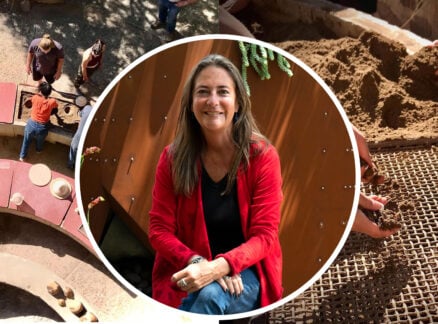
August 21, 2015
Modern Architecture Tells an Incomplete Story
The fourth installment of the ten-part Biophilia and Healing Environments series examines how architects ignored complex human responses to the built environment in their enthusiasm for the supposed mechanical efficiencies of the industrial approach to placemaking.
Figure 8. Philip Johnson’s Glass House moved to a parking lot has no biophilic properties.
Drawing by Nikos Salingaros
The extraordinary success of many 20th and 21st Century buildings with organic shapes has arisen almost entirely from biophilia. I brush aside their architects’ own explanations crediting technical aspects of the design process — such as paper crumpling, or using a particular design software — which have little to do with a building’s effect on users. It is safe to say that their clients paid for them and the juries of design competitions chose them because they felt a strong attraction to the original drawings. The finished buildings tend to lack the full spectrum of biophilic qualities, however, and so cannot be considered an unqualified success.
The biophilic qualities that make a building immediately attractive are perceived very differently at various distances. This can create a problem in buildings whose scaling relationships work against biophilia. A building could be biophilic as seen from a distance but not close up, or vice versa. Or, the building could incorporate no biophilic elements itself; yet steal biophilic credit from its natural surroundings. Famous examples of the latter are the Glass House (1949), by Philip Johnson, and the Farnsworth House (1945-1951) by Ludwig Mies van der Rohe, two transparent houses set in the woods.
In other cases, buildings may be biophilic close up. Biophilia is triggered by extensive use of polished stone, as in the marble of the Stoclet Palace (1905-1911), in Brussels, by Josef Hoffmann, and the marble, travertine, and red onyx of the German Pavilion (1929), also by Mies, at the International Exhibition in Barcelona. The large scale of those buildings, though, is not biophilic but severely unnatural in their geometry. Both use pools of water to soften stark exteriors — one factor of biophilic design (Kellert, 2008: Chapter 4). Their architects evidently understood the factors contributing to biophilia, even as they sought to break their designs away from it. Incompatible forces are at play in the work of these and other architects during this early modernist period.

Figure 9. Nikos at the Barcelona Pavilion in 2012.
Photo by Sophia Salingaros
The desire to embellish arises naturally when designing one’s own surroundings at an intimate scale. Bottom-up or generative design philosophies satisfy this impulse. Smaller scales represent ornament and elements of which ornament is composed. Ornament arises more naturally from bottom up, but using a rich form language can ensure that coherence is achieved from top down as well (Salingaros, 2006: Chapter 11). But such coherence is difficult if not impossible when top-down design employs smooth surfaces without adornment, sheer glass curtain walls, and sharply-edged windows and doors without frames. This is not an argument against top-down design per se, but against stylistic choices that omit the smaller scales. Top down fails when it omits small scale; bottom up never makes that choice.
Regardless of style, human health and comfort rely on the smaller scales, which allow the mind to register the crucial presence or absence of a complete scaling hierarchy in architecture.
The 20th century saw a massive and unprecedented application of industrial typologies and materials, imposing top-down styles that changed the way architecture and the city looked and felt worldwide. Proponents of the International Style considered it “rational”, because it was a product of an internal logic of clean, rectangular geometries [but see (Mehaffy & Salingaros, 2015: Chapter 3 & Appendix 1)]. This design philosophy’s driving force relies on drastic simplification and industrial materials in their raw form. Small scales are largely eliminated and ornament largely forbidden. Most people today identify “rational” design with simplistic geometries in a formal framework.
Top-down design combined with industrial materials merely omits complex structures on the small and intermediate scales. How can we adapt to human sensibilities if we don’t work with the available tectonic scales at all human dimensions? The answer is clear, however uncomfortable it may make some readers. The fundamental contradiction among the International Style, biophilia, and local adaptive architectures has not been resolved and cannot be. The reason is obvious: a generic non-biophilic style supposedly applicable everywhere cannot simultaneously adapt either to human nature or to local conditions. The latter vary widely around the globe. Human nature does not.
In their enthusiasm for the sheer power of the supposed mechanical efficiencies of the industrial approach to placemaking, architects ignored complex human responses to the built environment. Many architects still believe this was a valid choice, but it contradicts human biology.
Perceiving this, some architects ditched the International Style, proposing a re-validation of the traditional urban fabric and building typologies of their native lands. They discovered how to merge top-down design with biophilic adaptivity. Rediscovering the traditional city as a textbook of stored adaptive solutions that can be drawn upon for contemporary architecture opened the door to more innovative adaptive design.
Readings:
Stephen R. Kellert, Judith Heerwagen & Martin Mador, Editors (2008) Biophilic Design: The Theory, Science and Practice of Bringing Buildings to Life, John Wiley, New York. Chapter 4 by Martin L. Mador, “Water, Biophilic Design, and the Built Environment”.
Nikos A. Salingaros (2006) A Theory of Architecture, Umbau-Verlag, Solingen, Germany; reprinted 2014, Sustasis Press, Portland, Oregon and Vajra Books, Kathmandu, Nepal. Portions of Chapter 11 “Two Languages for Architecture” are re-published by ArchDaily, March-April 2014, available HERE.
Michael W. Mehaffy & Nikos A. Salingaros (2015) Design for a Living Planet: Settlement, Science, and the Human Future, Sustasis Press, Portland, Oregon and Vajra Books, Kathmandu, Nepal. Chapter 3 “How Modernism Got Square” originally appeared in Metropolis, 19 April 2013. Appendix 1 “The Fraudulent Evolution From Artisan to Industrial” originally appeared in ArchDaily, 17 July 2013.





